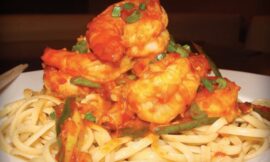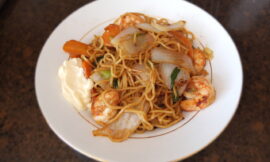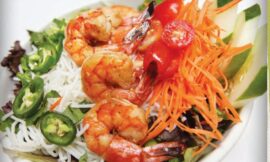MARCO POLO NOODLE BOWL
The typical spaghetti Pomodoro with shrimp is given an East-meets-West twist with the addition of ginger, fish sauce, and Thai basil.
1424 North Highland Avenue, Atlanta, GA 30306 (404) 888-0777 Doc Chey’s Noodle House
There are two other sites in Atlanta and one in Asheville, North Carolina. Rich Chey, a pan-Asian chef
For more than sixteen years, Doc Chey’s has provided residents of Atlanta, Georgia, and Asheville, North Carolina, with “Great Food… Good Karma.”
Rich Chey, a chef
Rich Chey’s travels around Asia over sixteen years ago gave rise to the concept for Doc Chey’s. “Due to the Ramen shops and their place in society, I truly liked Japan. They are Japan’s equivalent of diners, where customers may get tasty, affordably priced cuisine delivered promptly. In 1997, Chey and Brook Messina launched the first Doc Chey’s.
1-tablespoon vegetable oil
12 prawns
1 tsp minced garlic, 1 cup/160 g sliced onions, 2 cups/175 g chopped bok choy, and 1 cup/170 g julienned red peppers
180 ml/3/4 cup Tomato Ginger Sauce (recipe below)
12 Thai basil leaves
180 grams/2 cups of cooked udon noodles
1 slice of lime
1 tablespoon chopped cilantro
2 tablespoons of vegetable oil
1 cup/160 grams of chopped onions
1 tablespoon minced garlic
3 tbsp. minced ginger
1-tablespoon rice vinegar
650 g/four cups of chopped tomatoes (including juice)
475 ml/two cups of water
1 teaspoon kosher salt
2 teaspoons chili flakes
2 tbsp. fish sauce
- In a pan, heat the oil. Shrimp should be cooked until the exterior is charred and they start to turn pink. Take out of the pan and place aside.
- Add extra oil to the pan and cook the garlic until it is fragrant. Add the bok choy, red peppers, and onions and cook until the bok choy starts to wilt.
- Cook the tomato ginger sauce, shrimp, and Thai basil in the pan until the sauce bubbles.
- Include the udon noodles and cook them further until they are hot. Place the ingredients in a bowl and top with a lime slice and cilantro that has been chopped.
- Warm the pot’s oil. Sauté the onions and garlic together until the onions start to turn golden.
- Once the rice vinegar is boiled off, add the ginger.
- Include the tomato, salt, water, and chili flakes. Contents should be brought to a boil, then simmered for 30 minutes on a low heat.
- Add fish sauce and stir.
OMUSOBA
A shrimp omelet in Japanese style
Applied to the Omusoba Sauce:
150 ml/2.3 cups ketchup
25 ml/1/8 cup soy sauce
75 ml/1/3 cup tonkatsu sauce
50 ml/1/4 cup honey
Plant-based oil
1 egg
One-half of a Shrimp Yakisoba dish (see page 74)
Garnish: Mayonnaise
Beni Aonori Shouga
- Combine the Omusoba sauce ingredients and put aside.
- Place a frying pan over medium heat and add a little oil.
- Crack one egg into a bowl and whisk it just a little.
- Pour the egg onto the heated pan and spread it out as you would a crepe. Cook the egg until it is halfway done.
- Arrange the egg on top of the half-portion of shrimp yakisoba. Gently round the yakisoba with the egg using your hands.
- Add aonori, beni shouga, omusoba sauce, and mayonnaise as garnish.
(514) 931-8833 Imadake 4006 Sainte-Catherine Street West Westmount, Quebec H3Z 1P2
Japanese chef Mineho Okunishi’s cuisine
Imadake aspires to provide everyone with a genuine Izakaya experience in Japan. This applies to all facets of the restaurant, including the menus, chefs, sakes, and music. They think that environmental protection shouldn’t be sacrificed for business.
The ingredients are entirely sustainably sourced. The seafood adheres to “OceanWise” principles, while the meats and vegetables are all organic. Imadake reduces its environmental effect through recycling and using energy-efficient equipment.
Mineho Okunishi, a chef
Over the course of 10 years, chef Mineho Okunishi has worked at a number of restaurants around Japan. She is skilled in a variety of culinary techniques, including kaiseki and izakaya. He wants Montrealers to be able to sample the cuisine of a genuine Japanese izakaya without ever having to go to Japan.
PAD WUN SEN KYUNG Glass noodles with red curry sauce and coconut
Canada (416) 598-4719 Queen Mother Cafe 208 Queen Street West Toronto, ON M5V 1Z2
Cuisine: Noy Phangnanouvong, a Lao-Thai and international chef
The Queen Mum, as the eatery is lovingly referred to by its many regulars, is located in the center of the Entertainment District in a landmark structure that is more than 150 years old.
2 tablespoons of vegetable oil
2 tablespoons red curry paste
2 sliced medium yellow onions
24 shrimp (16-20 size), skinned and deveined, tail on 1 carrot, julienned 1 red pepper, julienned 12 snow peas, julienned
1 big can (18.6 oz/560 ml) of coconut milk
3 bunches of glass noodles, drained after 15 minutes in cold water
1 tbsp. fish sauce
1 tablespoon oyster sauce
3 julienned lime leaves
cilantro sprigs as a garnish
- In a large sauté pan, heat the oil over medium-high heat.
- Stir-fry the onion and carrot with the curry paste until the onion is tender.
- Stir-fry the shrimp, red pepper, and snow peas for 2 minutes.
- Add the glass noodles and coconut milk, then boil.
- Stir together the fish sauce and oyster sauce.
- Include lime leaves.
- Serve right away with cilantro as a garnish.
As a refugee from the Laotian civil war, chef Noy Phangnanouvong Phangnanouvong landed in Canada in 1980. Her mother and aunts taught her how to cook at home, and she joined The Queen Mum in 1989 as a prep worker. She swiftly picked up Western culinary techniques while demonstrating her comfort and aptitude in the kitchen, moving through the ranks to line cook, sous chef, and then chef in 1995.
Concerning Red Curry Paste
Paste is a mixture of fresh herbs, roots, and other components that are crushed and mixed with dry spices to make a paste, as opposed to spice powders. The red curry paste used here, which has overtones of ginger and garlic, is among the most well-liked of the many varieties of curry pastes.
It is not very spicy but has a slight bite. The oil’s greater temperature, which allows the paste to release more flavors from the herbs and spices that wouldn’t come out with simple cooking, is why pastes are often stir-fried with oil.
LEMONGRASS SHRIMP AND RICE NOODLE SALAD
How to Read an Italian Wine Label





